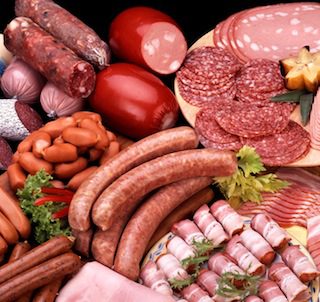Does Processed Meat Cause Cancer?
Wow, what a week. The World Health Organization classified processed meats and, to a lesser degree, red meat as cancer causing.1 Vegetarians and vegans rejoiced. Facebook blew up with bacon memes.
As with everything, there is some truth to the new claims. But the WHO needs to draw a line in the sand with its recommendations. Yes, the evidence suggests a link between processed and red meats and bowel cancer. But it does not state the magnitude of effect (I don’t believe they can use “-ish” at the end of their recommendations.)
Let’s take a step back and see what confounding variables could affect the research. We will also take a look at how we can improve our health with some general guidelines.

Self-Reported Intake and Nutrition Studies
The WHO used over 800 studies to come to their conclusions. But people are awful at reporting nutrition intake. Dhurandhar and colleagues put out a report questioning the merit of studies that include nutrition questionnaires and self-reported measurements.2 Some studies show underreporting by 40 percent or more. While the underreporting was mainly regarding energy balance and weight loss, the wide range should affect how we interpret the studies on the amount of red and processed meats.
To quote the author, “Dietary underreporting varies with the type of foods consumed, age, gender, smoking habits, education, social class, dietary restraint, the body mass index of respondent, and other life-stage factors.”
“Even when controlled studies are completed, the sample size is small and general population conclusions often cannot be drawn.”
So not only is underreporting an issue, it also varies depending on the subject.Due to financial and size restraints, more controlled nutrition studies are nearly impossible. Even when controlled studies are completed, the sample size is small and general population conclusions often cannot be drawn.
Quality of Product
There are so many different types of meat. Think of people in a small village in Italy who raise their own pig and cure it themselves. Compare that to a cheap hot dog on the street. Does quality matter? Of course, but it’s difficult to tease out those differences. A local, pasture-raised cow produces different meat than a factory farm equivalent. This further clouds the research.
Preparation
Burning and charring meat is a problem because it produces different compounds that can be carcinogenic. Unfortunately it would be almost impossible to control for burnt versus medium cooking outcomes, so it is all lumped together in the WHO research..
Lifestyles of the Subjects
What other factors can contribute to bowel cancer? For people eating the most cured meats, how many vegetables do they also eat? These are all questions that can play a huge role in getting more specific research. Fruits and vegetables are well established to be protective against certain cancers. Things like alcohol and smoking are not, so what happens when these factors are combined with high intake of processed and red meats? The research does not address these lifestyle questions.
The Real Take-Home Points
Use a Plant Based Diet
Notice I didn’t say go vegetarian. That’s a personal choice. But becoming more plant-based in your diet is a good idea. Fruits and vegetables are known to have an inverse relationship with cancer. And having a smaller portion of meat will save money and allow you to get higher quality meat.
Of course, the same problems that plague the meat research also show up with studies on fruits and vegetables. But I’d hedge my bets that the correlation between vegetables and less cancer is a good one. This doesn’t mean you need to eat broccoli with your burnt bacon. It’s about patterns, not individual meals. Having a long-term high intake of fruits and vegetables will be protective to your health.
Don’t Burn Meat
Heterocyclic amines and other compounds are formed during high heat cooking and may contribute to the cancer correlation. Many factors are involved here, like fat and iron content, exact temperatures, time on the grill, and more. The takeaway? Avoid charring the outside of your steak.
“There is always some truth to the hysteria, but there’s also a lot of misinformation.”
A slow cooker is a great way to lock in flavor without burning. Cooking longer with lower heat is another option, depending on what kind of meat you’re preparing. Cooking bacon in the oven is quite flavorful. Sausages come out great boiled instead of grilled. If burning the outside is unavoidable, just slice the burnt piece off.
Buy Higher Quality Cured Meats
A huge salami sandwich made with cheap deli meat is different from a high-quality, locally made salami. The second option will have more flavor, and you won’t need as much of it. Shop for local brands and check out ethnic shops. You’ll pay more, which will also help you savor it. Dried fruit, good cheese, and a high-quality cured meat is a great meal that won’t take much to fill you up.
Don’t Be Crazy
When the media dropped the bomb that red and cured meat causes cancer, people went bacon crazy. What we eat is a big part of our values, so people on both sides either celebrated or became defensive. Just remember to be skeptical and use common sense. There is always some truth to the hysteria, but there’s also a lot of misinformation.
Photo courtesy of Shutterstock.


